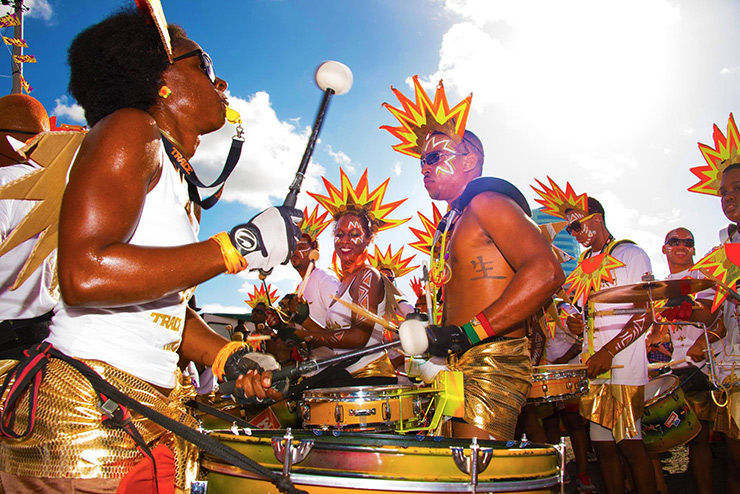
Musicians jamming’ at Martinique Carnival; credit Martinique Tourism
Martinique Music
Carnival, known as Vaval on Martinique, showcases the vital role Martinique Music to local culture. With Martinican big marching bands leading revelers across the island, they is no better way to experience local culture. Like Guadeloupe, Martinique features participatory, call-and-response style songs during its Vaval celebrations.
In the early 20th century on Martinique, Creole bands travelled on trucks or small carts during Vaval, playing a music known as Vidé (pronounced “video”). In the 1980s, large marching bands of fifty plus people became common, featuring percussionists, brass horn players and dancers. These large bands, known as groups à pied, are identified by their neighborhood.
Beguine Vidé is an up tempo version of the biguine rhythm combined other carnival elements, such as the bandleader singing a verse and the audience responding. Modern instrumentation includes a improvised drums made from containers of all kinds, plastic plumbing, bells, tanbou débonda, bélé chacha, tibwa and bélé drums. Aside from the biguine vidé bands, Vaval includes song and costume contests, masquerading and zouk parties.
Bélé is a legacy of the slave music tradition with a huge tambour drum that players ride as though it was a horse. It is characterized, in its rhythm, by the “tibwa” (two wooden sticks) played on a length of bamboo mounted on a stand to the tambour bélé, and is often accompanied by a chacha. The tibwa rhythm plays a basic pattern, while percussionists introduce improvisations that give it ‘flava..
It is organized in a certain way, the first entry of the singer (lavwa) and choir (lavwa Deye or “answer”). Then the Bwatè sets the pace, followed by bélé drum. Finally, the dancers take the stage. A dialogue is created between the dancers and the drummer. The answer plays opposite the singer, the audience can also participate. The bélé song-dances include, bélé dous, bélé pitjè, biguine bélé, bélé belya, and gran ball. Singers, dancers, musicians and audiences are lured together by its mesmerizing rhythms.
In French Caribbean culture, the term kwadril is a Creole term referring to a folk dance derived from the quadrille. kwadril dances consist of proper quadrille sets, plus creolized versions of 19th-century couple dances: biguines, mazouks and valses Créoles.
Instrumentation consists of variable combinations of accordion, guitar, violin, tanbou dibas, chacham (usually a single metal cylinder held in both hands), malakach (maracas), triangle, tibwa and syak, a bamboo rasp held with one hand.
